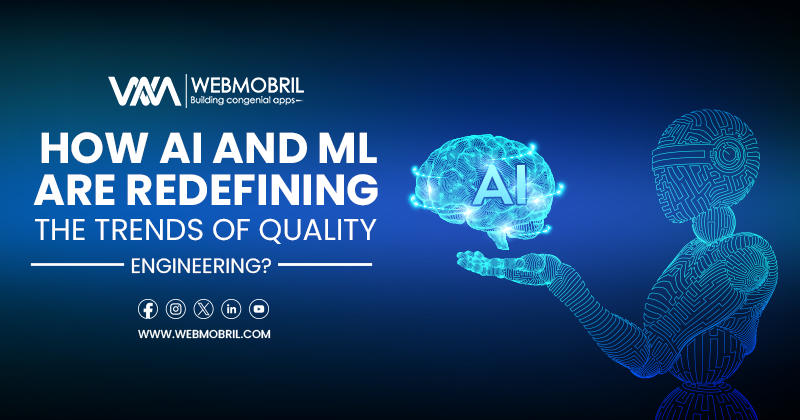With automation influencing almost every field, it has been around for a while in software testing as well. As manual software testing seems inept with the rising demands for speedier releases and upgrades, companies are moving to automated testing procedures.
But merely switching to automated testing procedures is not enough. An assessment of traditional automated software testing procedures shows that they are not producing the intended results in comparison to the investment made in them. The main reason was found to be the use of the waterfall software development technique, freezing the room for software testing. Thus, companies like WebMobril Inc. – a Custom Software Development Company, have realized the need to move the quality analysis process early in the software development lifecycle and have started with advanced Quality Engineering.
Software quality engineering means moving the emphasis from testing quality at the end to ensuring that quality is embedded into the code while it is being created. Having software testing run concurrently with the development process, using automation, enables companies to overcome the challenges faced by the outmoded software development approach. The modern approach is a blend of artificial intelligence and machine learning that helps with a more effective and faster approach to applying automation.
How are AI and ML Transforming the Landscape of Software Testing?
With customer expectations becoming more complex, professionals have resorted to artificial intelligence (AI) in quality assurance (QA) testing to migrate toward advanced automation. Companies are increasingly becoming dependent on machines to satisfy their test code requirements, as they move away from the old manual waterfall testing strategy.
Top Market Factors Leading to the Change
Integrating the Metaverse
Acceptance of the metaverse is growing more popular day by day, and the future has already landed. The expanding spectrum of metaverse applications enables companies to overcome physical constraints and improve digital connections. This gives them a unique opportunity to improve their Quality Engineering (QE) strategies and execution.
Unleashing the Potential of 5G Computing

The development of innovative 5G and IoT testing technologies has the potential to boost transparency, shorten time-to-market, and maximize revenue streams for 5G, significantly altering the role of QE leaders.
Increasing As-a-Service Subscriptions
As subscription-based “as-a-service” models expand, Quality Engineering (QE) will be required to apply adaptive, data-driven, and analytics-oriented testing methodologies for assessing client-conversion rates and lifetime value.
Supply Chain Network Optimization
Traditional functional silos are becoming obsolete, and leading-edge Quality Engineering (QE) technology may help businesses in supporting the move from traditional linear models to linked digital supply networks, promoting better resilience.
Maintaining Contact with Specialized Devices
In the market, smart products with embedded gadgets are common. As the complexity of the ecosystem develops, Quality Engineering (QE) should build a testing environment capable of evaluating embedded software and firmware across a wide range of devices.
What does the Trend say?
In 2023, corporate infrastructure software investment is predicted to grow by 14.1% in constant US dollars to achieve $449 billion in current US dollars. By 2027, the market is estimated to reach $735 billion, rising at a compound annual growth rate (CAGR) of 12.6% during 2022-2027.
Attributes of Testing Tools Navigated by AI
Gathering Requirements
Gathering requirements is a crucial step in every software development project, but it could be a difficult task without the support of AI-based software testing. This job includes doing arduous tasks such as managing deliveries, monitoring approvals, and creating reports. Taking the help of technology, you can have useful insights into analyzing complex systems through established key performance indicators (KPIs).
Exploratory Testing Made Simple
Using AI in software testing allows the achievement of anticipated objectives with fewer resources and lines of code. AI systems work at breakneck speeds, flawlessly juggling activities like learning, test design, and execution. With the help of smart agents, this technology efficiently identifies testing parameters and discovers system weaknesses.
Visual Verification
AI in testing provides a variety of leading-edge benefits, in particular, its advanced pattern and picture recognition skills. This feature enables the detection of flaws in the user interface through visual testing. AI can recognize and thoroughly evaluate UI controls at the pixel level regardless of their size or design.
AI-Assisted Error Detection
A code problem can hamper your software’s basic functioning, and the more the flaws are, the more difficult it is to uncover these coding issues. Nonetheless, the use of artificial intelligence (AI) in quality assurance (QA) testing streamlines the process of detecting errors, improves testing methods, and forecasts possible failure areas. This capability has the potential to improve customer satisfaction while lowering overall costs.
Increase Code Coverage
Code coverage dimensions reveal which code statements have been examined during a test run and which ones are not tested. AI testing may help you get the best level of test coverage with meticulous preparation. In fact, with the right tools, you may set the aim of reaching 100% code coverage.
Read More blogs: What Design Elements Make a Game More Immersive? 4 Practices to Apply to Create a Better Immersive Experience
Conclusion
The landscape of software development has marked a transformative era with the integration of Artificial Intelligence (AI) and Machine Learning (ML) in the process of Quality Engineering. Through their smart automation, prognostic analytics, and adaptive capabilities, these technologies have redefined the Software Quality Engineering & Testing process. These innovations- ranging from intelligent test automation frameworks to predictive performance analysis, are not only simplifying traditional testing processes but also proactively overcoming difficulties in the dynamic world of software development.
As innovation is at the core of WebMobril Inc., this custom software development company has already embraced Quality Engineering aided by AI and ML. We use the technology tactfully to evaluate enormous datasets, forecast potential problems, and self-optimize frameworks for testing, and thus lead with efficiency and accuracy in Quality Engineering.
Considering the ever-evolving demands for superior-quality software products, the future of Quality Engineering appears to be more agile, data-driven, and responsive.




